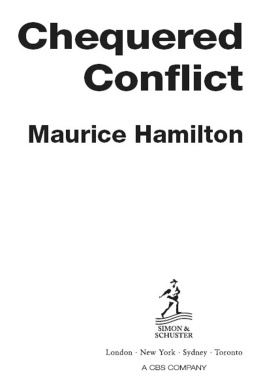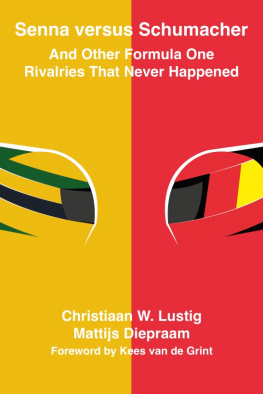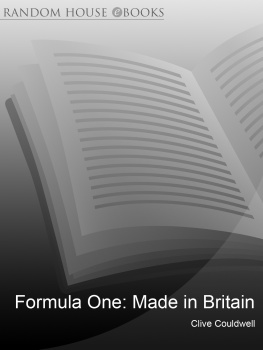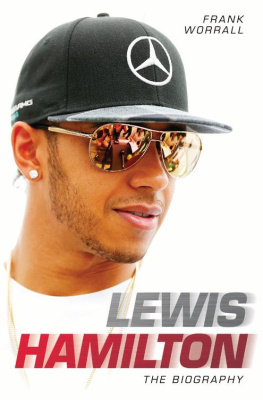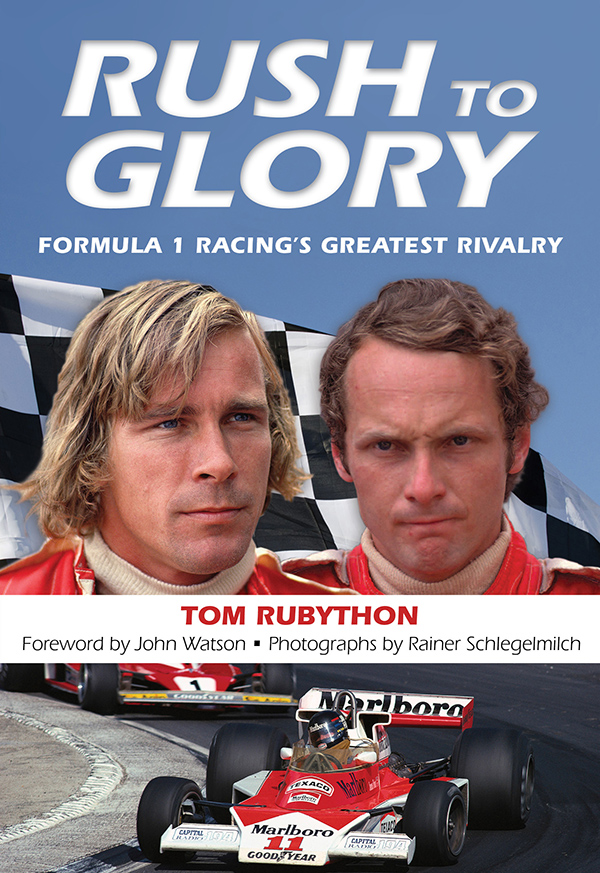R USH TO G LORY
Also by Tom Rubython
Life of OReilly
The Biography of Tony OReilly
The Rich 500
The 500 Richest People in Britain
The Life of Senna
The Biography of Ayrton Senna
Dog Story: An Anthology
The Life and Death of Our Best Friends
Shunt: The Story of James Hunt
The Biography of James Hunt
And God Created Burton
The Biography of Richard Burton
R USH TO G LORY
FORMULA 1 Racings Greatest Rivalry
T OM R UBYTHON
Foreword by John Watson
Photographs by Rainer Schlegelmilch
LYONS PRESS
Guilford, Connecticut
An imprint of Globe Pequot Press
Copyright 2011 Tom Rubython/Myrtle Electronic Press Ltd
Photographs Rainer Schlegelmilch
First published in the United Kingdom in 2011 as In the Name of Glory
First Lyons Press Edition, 2013
ALL RIGHTS RESERVED. No part of this book may be reproduced or transmitted in any form by any means, electronic or mechanical, including photocopying and recording, or by any information storage and retrieval system, except as may be expressly permitted in writing from the publisher. Requests for permission should be addressed to Globe Pequot Press, Attn: Rights and Permissions Department, PO Box 480, Guilford, CT 06437.
Lyons Press is an imprint of Globe Pequot Press.
Project editor: Meredith Dias
Layout: Lisa Reneson
Library of Congress Cataloging-in-Publication Data
Rubython, Tom.
Rush to glory : Formula 1 racings greatest rivalry / Tom Rubython ;
foreword by John Watson ; photographs by Rainer Schlegelmilch.
pages cm
Includes index.
E-ISBN 978-0-7627-9696-0
1. Grand Prix racingHistory. 2. Formula one automobilesHistory.
I. Title.
GV1029.15.R84 2013
796.72dc23
2013015035
Formula 1 is a trademark of Formula One World Championship Limited and does not imply an endorsement of this book.
C ONTENTS
A CKNOWLEDGMENTS
A book like this owes so many things to so many people. But, as always with any motor racing book featuring this era, I owe John Hogan the deepest thanks. John had unique insight into both Niki Lauda and James Hunt in 1976; he was their mentor, their guru, their paymaster, and their best friend during that remarkable season.
I believe that John knows what really went on in 1976 better than any other man alive. And I am very glad that he confided in me the long-forgotten details and dramas.
Its also true to say that without John, there would have been no James Hunt. He created him, nurtured him, developed him, and saved him from himself when he needed saving, which was pretty often from what I observed.
Equally, when Niki was in trouble, he always turned to John to help him out of the holes he continually seemed to be digging for himself at certain points during 1976.
Johns account of 1976 has helped blow away the myths surrounding James and Niki, of which there were many. Both drivers were lucky to have had such a wise friend on their side.
The other man who played a significant role that season was Bernie Ecclestone. He was close to both men, though not in the same way as John Hogan. Bernie wanted James and Niki to drive for his Brabham team in 1976 and made plenty of effort to try and make it happen. But for a man who likes getting what he wants, for once Bernie failed on both counts. If he hadnt, history would have been very different. We must thank him for failing; otherwise, we might have been denied the dramas of 1976.
I also have to thank previous authors, notably Gerald Donaldson and the late, great Christopher Hilton. Chriss death in 2010 was a very sad loss to the Formula One community, and his books Portrait of a Champion and Memories were extremely useful to me. This book is all the better for Chriss contribution to motor racings history.
I am also deeply indebted to Andrew Frankl, cofounder of Car magazine.
Andrew has the best memory of anyone I know about what happened at the 1976 British Grand Prix at Brands Hatch. His recollections of that remarkable day bring alive a whole chapter that otherwise would have had to rely on far less reliable, less colorful, and less graphic sources.
Equally, Philippe Gurdjians character insights into both James and Niki were incredibly valuable to me. Few people know about the unique contribution Philippe has made behind the scenes to Formula One over the years. Luckily, I do, and so did James and Niki, as two of his many beneficiaries.
Stirling Moss was in the thick of it during 1976, working for American television. He was also particularly close to James Hunt, making his background recollections a treat to include in this book.
Equally, Andrew Marriott was close to Hunt during 1976 and, as usual, saw things that others didnt see in the backgroundmuch of which make up the fabric of this book.
John Watson, as ever, was my principal guide to James and Nikis Formula One career from an insiders perspective. He was there and doing it, and therefore his recollections are invaluable. Regardless of that, John knows what hes about where motor racing is concerned. As anyone who knows him will attest, John has very particular and forthright views, and woe betide anyone who might disagree with them. Luckily, his view of things almost always coincided with my own, which made him a very good collaborator. Johns greatest contribution is the time he is prepared to give to journalists and authors and the effort he puts into answering our questions.
Max Mosley was also very close to James and Niki and has unique insights of those times in the early 70s when both drivers were struggling newcomers.
Max, James, and Niki had the most unusual of relationships and shared good and bad times together on the way up the motor racing ladder. Now that Max has retired from his onerous duties, he can tell it like it was in a manner that he was not necessarily able to do in the past.
Peter Collins is an admirer of the achievements of both James Hunt and Niki Lauda, and no one can analyze a Formula One situation like Peter. People who know me will know that I value Peters opinion most highly.
People who may have read my other books will know this is my shortest yet. That is simply because it is the story of a year and is therefore very concentrated. It may be short, but the effort expended upon it was still great, and I cannot finish here without thanking my own people who worked on the original edition of this book.
David Peett and Mary Hynes, as always, took care of sales. Ania Grzesik designed the original edition, as she does all my books, and Kiran Toor, our chief sub-editor, took care of the words, as she always does.
Thanks also to John Blunsden, my personal guru, for his wise publishing counsel. A few words from John can be worth thousands of dollars in saved costs.
For this book, I chose to work with Rainer Schlegelmilch exclusively on the photographs. Rainer is Formula Ones top photographer and has been since David Phipps retired. In truth, its wrong to describe Rainer as a photographer, as he is a true artist. His photographs are really more akin to paintings, such is the care that goes into each one. Anyone who has examined his work will know that without being told. Thanks also to Stefano Luzzatto and Boris Schlegelmilch for handling the nuts and bolts of the photographic process.
The usual thanks to David Browne, Jo Buck, Ian Foyster, and Peter Milton at our UK printers. Printing a book properly so that it is a delight in a readers hands is no easy task, but they manage it so effortlessly and painlessly. They also made sure the UK edition arrived in the shops on time.




